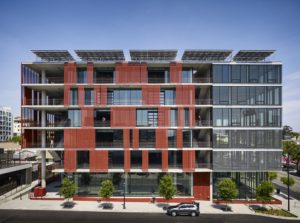With cities and states pursing renewable portfolio standards and national calls to decarbonize the grid by 2035, does efficiency still matter with a clean grid? The first answer: yes, energy efficiency benefits are, as they have been for decades, delivering lower energy costs to homeowners and businesses and creating opportunities for utilities to avoid expensive development in new generation resources. Put simply, when buildings demand less energy, utilities can build smaller capacity renewable energy plants, reducing capital costs, and keeping customer energy prices affordable. The second answer: it depends. Jurisdictions and utilities need to evaluate the opportunities that fit within their climate action plan goals and understand their capacity to make change.
Put simply, when buildings demand less energy, utilities can build smaller capacity renewable energy plants, reducing capital costs, and keeping customer energy prices affordable.
Codes, policies, market investment, and market activation are common mechanisms for transformation. The “Getting to Zero” energy and carbon approach includes a strategic balance between energy efficiency, renewable energy, grid integration plus storage, and fuel decarbonization. California and New York are good examples to study with their respective combination of strategies and tactics and potentially massive market power. These two states represent the fourth largest world economy and have the most ambitious carbon and greenhouse gas (GHG) reduction goals and actions. In general, both states have policy-heavy strategies for decarbonization. California is setting visionary aims, ratcheting up code stringency, and stoking the market to develop solutions, while New York is investing in aggressive policymaking and business investment to stimulate a clean economy. Both states provide insight into the combination of NBI’s Five Foundations of Zero Carbon Building Policies.
California Seeks Market-Based Solution Set
For decades, energy efficiency policy has been at the core of the Golden State’s approach to fight climate change and initially focused on zero energy goals. But, as their focus has moved to decarbonization, California’s strategy includes frequently updating the energy efficiency of the building code and actualizing its 100% renewable energy portfolio (RPS) to create efficient buildings that use 100% renewable energy.
California has been targeting codes, policies, and mandates, and inviting the market to develop tactics to comply. The state responds to market barriers by revising policies and metrics. For example, the abundance of renewable energy during non-peak hours (also known as the “duck curve”), requires utilities to incentivize or otherwise encourage customers to change how and when they use energy. Energy storage, load shifting, and other strategies can help meet the demand, and California policymakers are pursuing programs and incentives to encourage the shift.
California’s Title 24 commercial energy code influences the long-term energy efficiency of the state’s energy delivery system. Title 24 regulates and assigns a value for the energy performance of building envelopes, lighting, water heating, and HVAC systems using a metric call time-dependent value (TDV). The metric calculation signals the critical aspect of a building’s energy use based on modeled time of day, seasons, geography, or fuel type. Code officials are evaluating a new metric that can address the benefit of energy storage to create a balance between energy demand and production.
New York Uses Policy Levers to Drive Outcomes
Similar to California, New York is also focused on a policy-approach to achieve its climate goals, including 100% carbon-free electricity by 2040 and economy-wide, carbon neutral emissions by 2050.
The Empire State invests in its utility grid by increasing carbon-free energy sources and adds deployable renewable energy assets that are able to respond to peak loads. Investing in grid tactics not only ensures that the transmission assets are in place for a responsive grid but it increases the number of clean energy jobs, spurring economic development.
New York continues to stimulate the economy through the implementation of efficiency programs, such as New York State Energy Research and Development Authority (NYSERDA) RetrofitNY. Knowing that efficiency activities may disrupt occupants and business operations, NYSERDA programs focus on decarbonizing heating and hot water systems, as well as non-intrusive envelope upgrades. RetrofitNY is working to adopt the successful European multifamily retrofit program, Energiesprong, to increase energy efficiency at a percentage of the cost of conventional construction. The combination of policy, state investment, and market-driven innovation is a model for creating new industries and skilled jobs in New York while reducing greenhouse gas emissions.
The RetrofitNY model works to drive down the cost of efficiency upgrades for multifamily housing by creating demand for packages of efficiency measures, which includes insulation, on-site energy generation, building controls, heat pumps, etc. As an added benefit, manufacturers are informed of the future market demand, allowing them to prepare to supply applicable products. As the demand rises and more manufacturers offer the requisite efficiency products, the cost is driven down to a cost-neutral position. The program mobilizes building industry innovation to generate new jobs and financing opportunities—all while dramatically reducing GHG emissions.
The Final Answer: Efficiency Matters
Both California and New York are pursuing a combination of policies, investment, and market innovation to balance energy efficiency, renewable energy, and grid integration in buildings. And efficiency matters greatly…….but it seems that on the West Coast the California team sees a real need, with today’s “duck curve”, to understand that time of use can matter as much as quantity of use. New York is planning to get to that point with its Roadmap to Carbon Neutral Buildings, but first it must retrofit its millions of existing buildings to use a lot less energy.
As each state pursues its own path to decarbonize, we recognize that these efforts are trenching new ground with no models to follow. As such, California and New York as well as a growing list of other states are beginning to collaborate actively, and to learn from each other about strategies, planning, and results that will optimize their work. NBI is proud to work with our partners to support both California and New York in facilitating this progress.
by Stacey Hobart, Communications Director

